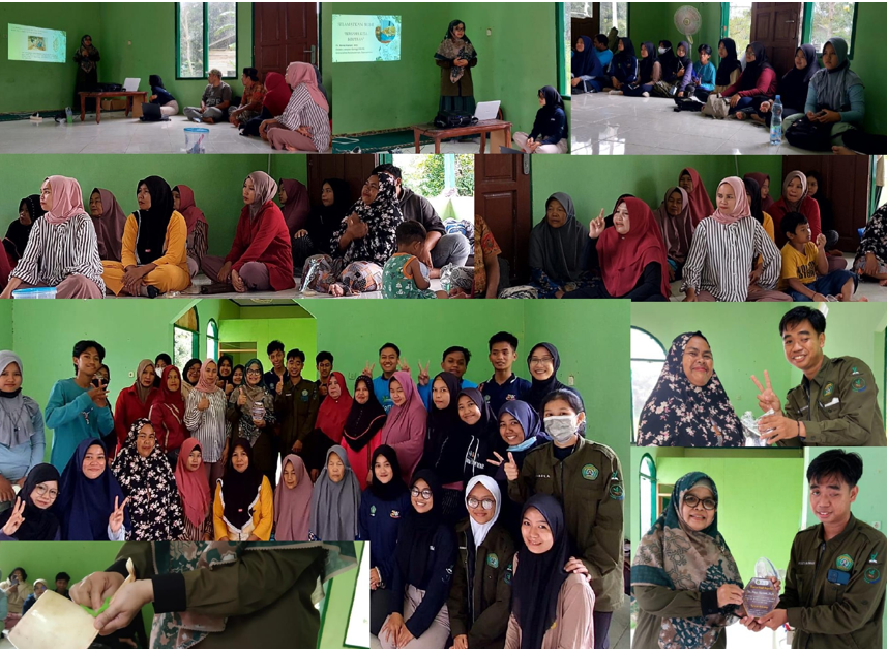Pelatihan Pembuatan Eco Enzym Kepada Masyarakat RT 27 dan 35 Desa Muang Ilir Samarinda
Main Article Content
Abstract
Eco enzyme training for locals, especially for housewives at RT. 13, Muang Ilir village, Lempake, in Samarinda. The training is about producing and obtaining benefits of environmentally friendly enzyme products, a program which designed to introduce participant on basic and practice of eco enzyme for producing and obtaining benefits from it. Eco enzyme is fluid resulting from fermentation of organic material, like leftovers (fruits and fresh vegetables) which is household waste by adding organic sugar into water with the help of microorganism. The fluid has numerous benefits for the environment and various applications in the household, agriculture, even in industrial sector. Socialization and training aim to provide information and educate people to care about waste and get benefits from it. Socialization was done by talk followed by practice for eco enzyme producing. After training, satisfaction result show the average value was very satisfactory (scored 5 of 94% participants) and satisfactory (scored 4 of 6% participants). Overall, all participants were very enthusiastic towards knowledge about eco enzyme, thus they can practice it at homes. Moreover, the locals hope a further collaboration in terms of sharing knowledge from university with Biology Department, FMIPA,and UKM Lesehan Cendikia Mulawarman University, especially for the locals from RT.13, Muang Ilir village, Lempake, in Samarinda.Â
Article Details

Jurnal Pemberdayaan Masyarakat is licensed under a Creative Commons Attribution 4.0 International License.
References
Dara Cospa, H. S. (2023). Pemberdayaan Perempuan Melalui Pelatihan Pembuatan Jelly Art Pudding di Kelurahan 30 Ilir Palembang Universitas Indo Global Mandiri. JPM (Jurnal Pemberdayaan Masyarakat), 8(1), 81–87. https://doi.org/10.21067/jpm.v8i1.7470
Darmayanti, T. E. (2022). Cara Membuat Eco-Enzyme yang Ramah Lingkungan. 1–8. http://news.maranatha.edu/featured/cara-membuat-eco-enzyme-yang-ramah-lingkungan
Farma, S. A., Putri, D. H., Handayani, D., Leilani, I., Putri, E., & Selaras, G. H. (2022). Application Of Eco Enzyme Biotechnology As Waste Management Organic For Preparation The Development Of. Jurnal Pelita Eksakta, 5(01), 59–64. https://doi.org/10.24036/pelitaeksakta/vol5-iss1/167
Hasanah, Y. (2021). Eco enzyme and its benefits for organic rice production and disinfectant. Journal of Saintech Transfer, 3(2), 119–128. https://doi.org/10.32734/jst.v3i2.4519
Imron, M. (2022). Eco Enzyme. https://zerowaste.id/zero-waste-lifestyle/eco-enzyme/
Indonesia Safety Sign. (2020). Jangan Dibuang Dulu ! Olah Sampah Dapur Anda Menjadi Eco Enzyme Serbaguna. 1–9. https://safetysignindonesia.id/jangan-dibuang-dulu-olah-sampah-dapur-anda-menjadi-eco-enzyme-serbaguna/
Indonesia Safety Sign. (2022). Mengenal Sampah Rumah Tangga dan Jenis-jenisnya. 81, 1–7. https://safetysignindonesia.id/mengenal-sampah-rumah-tangga-dan-jenis-jenisnya/
Jelita. (2020). Eco Enzyme dan Pencapaiannya yang luar biasa dalam Bidang Pertanian. 1–11. https://maitreyawira.ac.id/content/pendidikan/78-eco-enzyme-dan-pencapaiannya-yang-luar-biasa-dalam-bidang-pertanian-
LHKP, D. (2020). Mengenalkan Eco Enzym dan manfaatnya. 1–10.
Mavani, H. A. K., Tew, I. M., Wong, L., Yew, H. Z., Mahyuddin, A., Ghazali, R. A., & Pow, E. H. N. (2020). Antimicrobial efficacy of fruit peels eco-enzyme against Enterococcus faecalis: An in vitro study. International Journal of Environmental Research and Public Health, 17(14), 1–12. https://doi.org/10.3390/ijerph17145107
Meera, V. (2014). How to use Eco Enzyme? 1–21. http://www.enzymesos.com/what-is-eco-enzyme/how-to-use-eco-enzyme
Nadhirah, A. N. (2022). TPA Leuwi Gajah, 157 Warga Tewas Timbun Longsoran Sekrup & Baut Sunco. 6–9. https://galamedia.pikiran-rakyat.com/humaniora/pr-353793438/157-warga-tewas-timbun-longsoran-sampah-tpa-leuwigajah-tragedi-21-februari-2005#
Nurhamidah, N., Amida, N., Rohiat, S., & Elvinawati, E. (2021). Pengolahan Sampah Organik Menjadi Eco-Enzyme pada Level Rumah Tangga menuju Konsep Eco-Community. Andromeda: Jurnal Pengabdian Masyarakat Rafflesia, 1(2), 43–46. https://doi.org/10.33369/andromeda.v1i2.19241
Prasetio, V. M., Ristiawati, T., & Philiyanti, F. (2021). Manfaat Eco-Enzyme pada Lingkungan Hidup serta Workshop Pembuatan Eco-Enzyme. Darmacitya : Jurnal Pengabdian Kepada Masyarakat, 1(1), 21–29. http://journal.unj.ac.id/unj/index.php/darmacitya/article/view/24071
PRCF Indonesia. (2022). Mengenal Eco Enzym dan cara pembuatannya. 1.
Rizaty, M. A. (2021). Mayoritas Sampah Nasional dari Aktivitas Rumah Tangga pada 2020 | Databoks. 1–6. https://databoks.katadata.co.id/datapublish/2021/07/29/mayoritas-sampah-nasional-dari-aktivitas-rumah-tangga-pada-2020
Sasetyaningtyas, D. (2021). Manfaat dan Cara membuat Eco-Enzyme di rumah. Sustaination.Id, 1–31. https://sustaination.id/manfaat-dan-cara-membuat-eco-enzyme-di-rumah/
See, M. (2022). Knowing Various Benefits of Eco-enzyme . 22–25. https://www.beritajakarta.id/en/read/42566/knowing-various-benefits-of-eco-enzyme
Septiani, U., Oktavia, R., Dahlan, A., Tim, K. C., & Selatan, K. T. (2021). Eco Enzyme : Pengolahan Sampah Rumah Tangga Menjadi Produk Serbaguna di Yayasan Khazanah Kebajikan. Jurnal Universitas Muhamadiyah Jakarta, 02(1), 1–7.
Sirlani. (2020). Proses Penelitian Tentang Manfaat Eco Enzyme Lebih Dari 30 Tahun Oleh Doktor Rosukon Thailand Dan Dikembangkan Oleh Doktor Joean Oon Dari Malaysia. 1–9. https://fokusberitanasional.net/proses-penelitian-tentang-manfaat-eco-enzyme- lebih-dari-30-tahun-oleh-doktor-rosukon-thailand-dan-dikembangkan-oleh- doktor-joean-oon-dari-malaysia/
Wikaningrum, T., Hakiki, R., Astuti, M. P., Ismail, Y., & Sidjabat, F. M. (2022). The Eco Enzyme Application On Industrial Waste Activated. Indonesian Journal of Urban and Environmental Technology, 5(2), 115–133.

